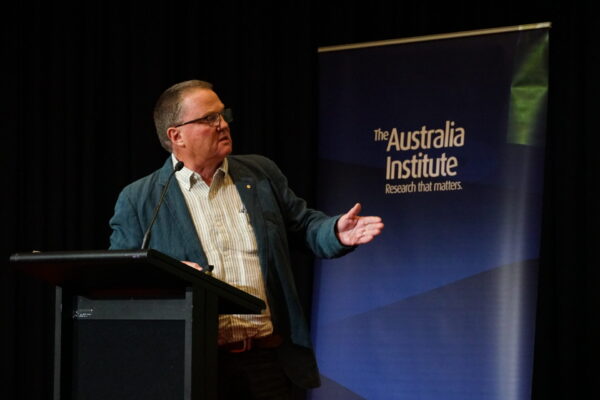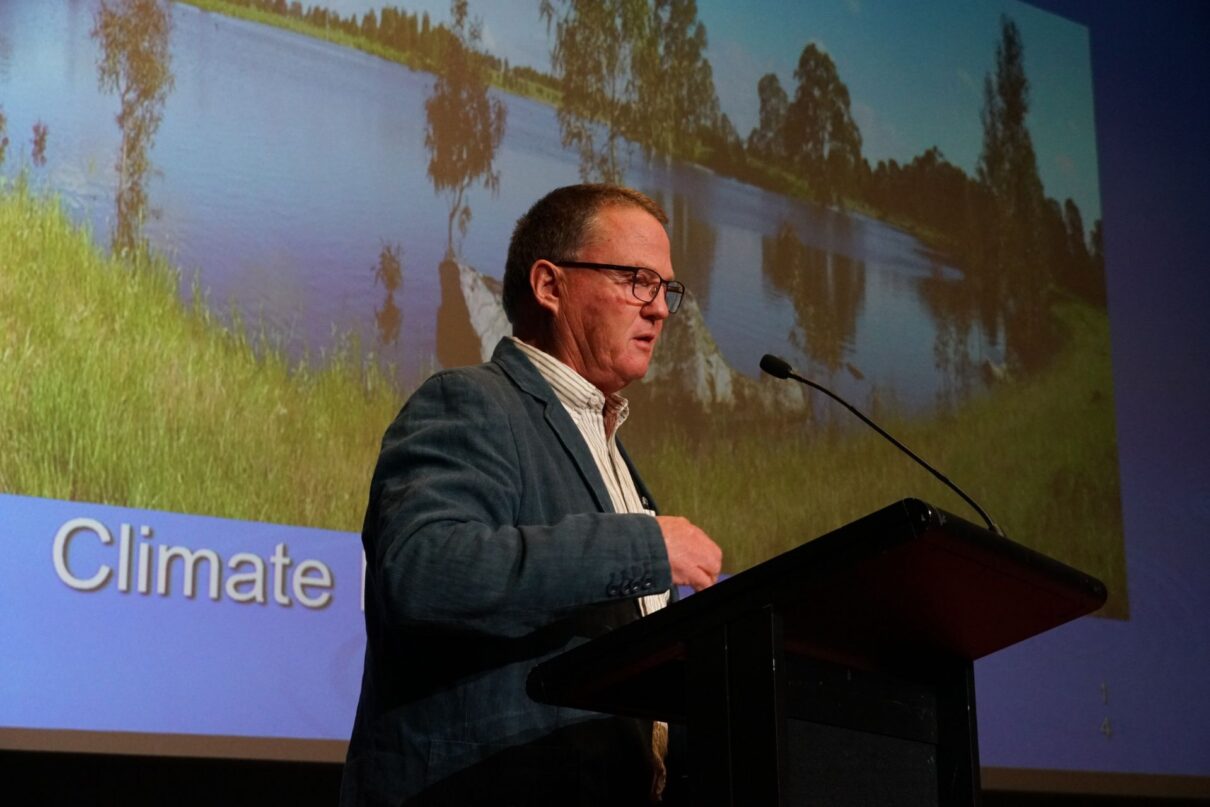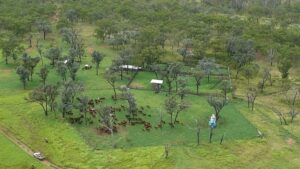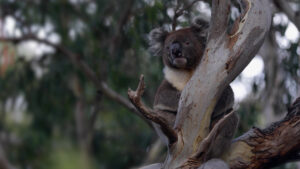Australian agriculture doesn’t have enough capacity to offset its own emissions, according to Mark Wootton from Jigsaw Farms.
Mark Wootton, Farmer and Environmental Steward at Jigsaw Farms, addressed the Australia Institute’s Climate Integrity Summit on 20 March 2024.
Carbon neutrality
Okay, so there’s a gentleman here, Andrew Campbell actually, who’ll appreciate this more than anyone, because he’s from this country. This is a shot in the 1960s of a property called Helm View. And for any of those, it’s actually a slide, so it’s a bit shabby, but it’s actually a pretty handy slide in terms of seeing what the landscape was like. And you can see through the middle for those who’ve got a keen eye, there’s a creek area which is dried out and all that discoloration is the salt area. And then you’ve got this great historical relic of when we were paid to bring back our red gum trees. So we’re in southwest Victoria looking towards the Grampians for people who are familiar with our area.
This is exactly the same spot and this is in the 1990s and this is post-Potter Foundation days, but with a little bit of work from us at this stage on broadening these plantations. So just to give you a really strict context, we’re about eight and a half thousand acres and this property is just over 1,300 acres of it. And we run a high input, high output system – so of livestock. So we’ve about 18,000 ewes and 800 cattle and at certain times of year it’s double that obviously because they’ve got lambs and calves – or a bit more than double.
And this was a model which was really significant for us and we were accidentally became carbon neutral. It wasn’t our intent. We were focusing on biodiversity, we were focusing on productivity, we were focusing on repairing, correction, salination, land slips, a whole bunch of other things going on. But just to give you a context of…it’ll all make sense in a minute where we’ve got.
That’s the same spot and you can see it’s just getting more mature and the trees are growing. We’ve thickened, we’ve introduced agroforestry at size into this block now, which has doubled the tree cover that was there. And that’s an important part, because if you actually understand the carbon story, it’s what we used to claim carbon neutrality later on.
And that’s actually last week in the same spot. And the dry isn’t because any disaster, it’s called autumn. So my son took that with a drone and that’s showing the maturity of where we’ve got to. I’m conscious of…there’s some people in the room and I have seen a couple have ag background, a couple have made themselves known to me, but I don’t want inundate you with a whole bunch of farmer talk, but you have to get a bit of context on what’s going on here in these farms.

To get to the carbon neutrality, we planted 19% down to permanent revegetation and/or saw logs – agroforestry trees. And that was how we got to offset, under measurement with the University of Melbourne in a large study they did in 2016, where it showed that we could run a high input – double the district stocking averages – have a lot of food and fibre leaving the place, but you could be carbon neutral because of the offsetting potential in this context insetting. And there’s a big difference between offsets and insets. And for ag it’s a really big difference because we use it for our own product to go forward. And that allowed us to claim carbon neutrality.
We’ve just completed the second study and it hasn’t gone to peer reviewing yet, but basically what it’s showing is we’re sitting on about 88% carbon neutrality. And the reason we’ve reached that point is because the maturation of the trees.
So if there’s nothing else you also take home from today, it’s carbon sequestration in the form of whatever you use to sequest, whether it’s trees, soil, carbon, or any other concept, it’s transitional because it’s not permanent. It’s permanent over a length of time and it’s still there. And it gives you biodiversity benefits, it gives you co-benefits. There’s a lot of good reasons to do it as there is with soil carbon.
In between our two studies, we reached saturation point in our soil carbons of three and a half organic soil carbon at measurement in 2016. So we could not use that in the second study, and if you actually…we’ll get to in a minute some of the aggregators that are claiming these quite false figures on what they can achieve. It just shows you that it’s quite limited what the landscape in Australia can do.
This is just to give you a very simple view of the scale of some of our plantations and what we’ve done the different colours is the different, that’s permanent revegetation, local species in there with a 20% buffer for species about an hour north of us to give a climate change buffer if all goes to shit -that’s a scientific term. And then above, that’s the agroforestry. That’s quite young
Then you get down to, this is same system but a different block. And you can see the agroforest is growing up and if you came to our farm today, that’s what you’d see except it wouldn’t be green. And you’ve got the maturing of trees and the Grampians in the background. And we’ve got deep water storage. You’ve got on the side of that for people in their trees, they’re spotted gums or maculata.
And then you’ve got your permanent re-veg on the border and that’s a deep water storage dam, which interestingly enough means we reduced our water usage by over 60% because deep water stays cooler so you don’t have as much evaporation. So just to get to the nutshell of that, we felt pretty good. We’ve got there, we were selling and we are still selling product into sort of boutique industries. We’ve got Coles carbon neutral beef, we’ve got Coles now doing an experiment with our lamb. We’ve got a lot of our wool product goes into ZQ specialist animal welfare based, responsible wool standard product to mainly North American sportswear markets. So there is a premium there to do it.
And so we were going well, this is a bit of a model, MLA used us. I went to the Egyptian COP where they held us up as this model and you can see what’s coming. Then we remeasured and we realised we’re in a bit of trouble. That’s just an aerial shot, that’s actually a video which is quite nice.
This is not dissimilar to most Australian ruminant based agriculture. So remember Australian agriculture is in broad numbers, is about 17% of our footprint.
Hitting the wall
Methane is our big baby. That’s our big problem. And the renewables and some of those other things allow our footprint are significant, but they’re still tiny. The big one is these amazing creatures that take crap pasture and produce high density, high value product, whether that’s fibre in the context of wool or in beef and lamb. This is also what shows you the key way of measuring this, and this is why it’s quite important, is carbon intensity.
So on your left hand side you’ll see that gives you range of what you could expect in normal farm operations in southern Australia, northern Australia’s a lot higher. Southern Australian beef and lamb is a much lower density just because of the intensity, and because we have much higher for fecundity levels, we have a lot more lambs and calves per maternal unit, therefore it’s a lot more carbon efficient.
That’s where we are sitting and that’s where we were sitting including sequestration going forward. So that’s nearly current.
So we are still pretty okay compared to others, but we’re not okay in terms of the climate because we still have a footprint.
The issue with this is, and this is where there’s an overlay, the science-based…SBTI targets initiative, which most food purchasers in the world have signed up to, has set they’re going to reach carbon neutrality – and it depends if your Unilever or Coles or whoever it is – at some point in the future. And to be able to achieve that, what they’ve signed up to – I don’t know if they realise this – is 90% of that carbon footprint has to be taken by in the supply line. So they can’t go buy offsets for a hundred percent of it. They can up to 10% where they can’t move it.
And that is a real problem for Australian agriculture because we are going to have people screaming to buy our products with these targets going forward, but we won’t be able to provide them because we can’t sequester the amount of carbon that we need to.
There’s also an overlay on all of this. Australian agriculture at 17% is probably only going to grow percentages, other industries quite rightly clean up their act. But we haven’t got a lot of tools in our toolbox to clean up our act with.
So then you’ve got these carbon…hang on, I’ve nearly finished this. This is a quick summary of what we do. We actually…2016 they’ve discovered in the second study where we reached it, it’s financial. We’ve planted about 1.3 million trees. So we’ve got a few trees out there to get to where we’re doing.

This is the one which is the critical one. So the permanent re-veg, which is your mixed species, probably the winners in biodiversity gains. We’ve gone from as an indicator species, we’ve gone from 46 birds when we started, to 174 birds now.
What’s happened? So you say, ‘oh, that’s really good’. Well it is really good except what’s happening here is that maturation is going on with those trees which are slowing down the sequestration rates. You know, well they’re still there and they’re still providing biodiversity and they’re still providing a lot of good things, a lot of co-benefits. They’re providing a lot of shelter for our livestock, which improves our lambing percentages. You’ve got a lot of good things going on, but from a pure carbon point of view, we’re going to hit the wall. And that’s the same for the rest of the Australian agriculture.
No matter what they do, if it’s a transitional thing, putting aside some of the fraudulent claims of soil carbon, they still will hit the wall because there’s a saturation point.
The carbon myth industry
The Guardian ran an article on us about three weeks ago after this study – I got 54 emails and anyone in the room who sent me one, I’m sorry I haven’t apologised – of what these great solutions to the problem are. And most of ’em related to soil carbon, which we don’t agree. So that’s the end of the slides.
So what the issue we have is Australian ag and RepuTex has come out recently, and Polly sent me the report – first Polly, not second Polly sent me the report. And in a nutshell, what they’re saying is we’re going to have three times the increase in ACCUs or the Australian government measurement tool for carbon in the next 10 years than what we’ve got now. And most of these will be in the land sector. So where farmers are, and remember this overlay, farmers have to offset their own emissions. You’ve got a drying landscape. We haven’t got enough capacity to offset our own emissions. And even if we did and we all did what we’ve done, it would only be transitional anyway. And we are then selling to other industries, oil or gas or whoever, coal, to offset their emissions when we need the emissions. So you can see there’s a bit of a crunch coming here.
So the RepuTex report’s quite interesting. They said, just relax guys, there’s going to be enough ACCUs to meet our safeguard mechanism’s expectations in the next 10 years. So oh, I relaxed then.
So Rich Eckard, who’s a bit of a star in this space, professor at Melbourne Uni, he argues that the biggest landscape change we are going to have for Australian agriculture since colonisation’s going to be this impact. So it is a really significant impact. We’re not talking about Mickey Mouse stuff.
So the problem for ag is twofold.
We’ve got this issue that we need to get our own footprint down without the tools.
We need to have the ability to do whatever we can within landscape. We’ve also got these aggregators going round, or sharks, as I call them.
And what they’re doing is they’ve got methodologies in their back pocket, they come onto farm, they sign up, they tick your clip it as it come through up anywhere between 15 and 50% cost. Sign off on the methodology. The responsibility for those land credits, those, sorry, the carbon credits by and large rest with the landholder, the farmer, the owner of that land. If they’re wrong in their methodology, which most are – and anyone who heard Andrew Macintosh’s talk last year would know that, and soil carbons even worse. There’s the Microsoft sample where Wilmot Ag have sold to Microsoft carbon credits and got a million dollars for them in 2021. And those carbon credits are out by seven to one. Falsified. Microsoft’s taken them off their registry at least, but they got the million bucks.
So this is the problem. You’ve got farmers dealing with trying to produce the most efficient food and fibre you can to get your footprint down at source.
You’ve got a problem with these aggregators coming in, trying to take the opportunities that they can from the farmers. You’ve got some farmers who just don’t recognise the problem and what we need to do is to move forward.
So I’ll finish up there other than to say that it’s a problem for ag coming forward, and I think that you need to be conscious of that these outside agencies are going to put a lot of pressure on farmers because it’s cash in hand. They’ll let you sign up for 25 years, they’ll say it’s all fine and dandy, and then that farmer’s going to turn around and have to sell a product, which they can’t offset. And they might be in the perverse situation that they’re entering into a market 25 years where that carbon credit, which they’ve sold for 30 or 40 bucks now is going to be three or four hundred dollars.
Thank you very much.
Between the Lines Newsletter
The biggest stories and the best analysis from the team at the Australia Institute, delivered to your inbox every fortnight.
You might also like
Letters to EPA, Department: Evidence demands state and federal action against fish farm licence renewals in Macquarie Harbour
The science is clear: Removing fish farming from Macquarie Harbour is an urgent priority to be actioned before this summer.
Here are 23 Times Carbon Offsets Were Found to be Dodgy
Carbon offsetting has received a lot of attention recently. As businesses and governments look to meet their climate targets, many are turning to carbon offsets. That is, they are paying someone else to reduce or avoid putting greenhouse gases into the atmosphere, so they don’t have to.
The carbon con killing koalas
The NSW Labor Government took office promising to create a vast koala sanctuary on the state’s mid-north coast – the Great Koala National Park. Despite the threat of koala extinction in the state, more than a year later the Great Koala National Park is yet to be established.


